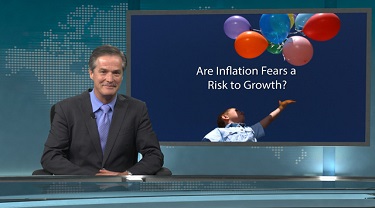Inflation fears are back. Dormant for well over a decade, prices again seem to be on the rise. Past episodes of inflation have done everything from aggravating analysts, politicians and the general public to inciting full-blown panic at times when the beast was out of control. These moments are etched on our collective memory, and we seem to have instant recall when there’s a whiff of inflation in the air. We can now sniff the scent again, and the fearmongers are stirring things up. Do they have a point, or are today’s jitters premature?
Is inflation back?
What are the numbers saying? In the US economy, the most visible measure is the consumer price index (CPI). On a year-to-year basis, the CPI has been creeping up, and is now above the Fed’s target mid-point at 2.9 per cent. Core inflation – the measure that strips out the more volatile food and energy sectors – is more tame at 2.2 per cent, but still above that sensitive mid-point, and has also risen sharply in the past four months.
Western Europe is also seeing upward movement. All-items CPI across the region jumped to the 2 per cent level recently after drifting around the 1.5 per cent level for a year or so. Measures of core inflation are still well contained, but the movement has grabbed the attention of the more inflation-averse Europeans.
Central banks in both economic areas have been responding. The Fed’s rate-tightening program is now into its 30th month. Europe is the laggard here, but the ECB has signalled the wind-up of its quantitative easing program by year end, with rate hikes now forecast for mid-2019. These moves are intended to accommodate the recent up-shift in growth, gently nudging the economy to keep prices at bay. The worrywarts aren’t convinced. They fear central banks are behind the curve.
Price increases look scary
Are they right? Not from a commodity price perspective; things are pretty tame on that front. But other headline numbers suggest they are. Official unemployment rates are either at or fast converging on cyclical low points, typically a harbinger of wage inflation. Also, capacity is tight on the industrial front, suggesting that final prices are in for a bout of unusual upward movement. Adding to the uncertainty are the possible cost increases arising from anti-trade measures – tariffs and the like.
Delve into these measures a bit deeper, though, and a different reality emerges. These ‘tight’ numbers have been generated by a period of growth that most agree has been sub-standard. In fact, they are artificially tight. On the labour front, the lack of job opportunities drove millions from the labour market, conveniently dropping them from the official count. Roll them into the numbers, and the stats don’t look quite as hot. The same is true with the capacity figures. They are artificially low due to abnormally sluggish investment – again, suppressed by weak performance. Nascent growth is now reviving both the labour and investment markets, and both are discovering that the market has far more capacity than headline numbers suggest.
Today’s inflation: good news
Here’s the rub: if there is indeed capacity to grow sustainably at a higher rate than in the entire post-recession phase, then the inflation we are seeing is maybe not the economy hitting some kind of capacity wall. It may well be the signal that is trying to jolt us out of our post-recession slumber, a marker that’s actually saying that it’s time to get back to that pre-recession reality – the old normal, where growth was enough to truly fully employ the economy’s resources.
If this is true, then it has lots to say about the conduct of monetary policy. It vindicates the gentle policy pursued to date by both the Fed and the ECB, which is just enough, it seems, to keep the economy from over-growing as it’s finding its feet again. Policy that is more aggressive might dull the ‘jump-start’ signal, and condemn us to the trepid performance that has given rise to so much political unrest. With today’s price movements, it’s going to take a lot of patience and nerve to steer the ship steadily.
The bottom line?
Prices are indeed on the rise again. Unlike past scary episodes, this price pop is not a sign that the economic cycle is tapped out, but that a reset to a higher growth trajectory is now underway. In this case, a little inflation is not a bad thing.





